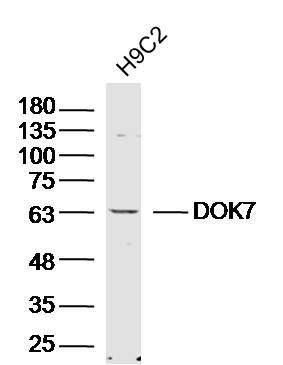The downstream of kinase family (Dok1-7) are members of a class of “docking” proteins that include the tyrosine kinase substrates IRS-1 and Cas, which contain multiple tyrosine residues and putative SH2 binding sites. Based on their similarities, the Dok family of proteins can be divided into three subgroups: Dok-1/2/3, Dok-4/5/6 and Dok-7. Through its interaction with muscle-specific receptor kinase (MuSK), Dok-7 is crucial for neuromuscular synaptogenesis and for MuSK activation. Mice lacking Dok-7 do not form neuromuscular synapses nor acetylcholine receptor clusters. Mutations in the Dok-7 gene can cause congenital myasthenic syndromes (CMA) — recessively inherited disorders characterized by muscle weakness.
Function:
Probable muscle-intrinsic activator of MUSK that plays an essential role in neuromuscular synaptogenesis. Acts in aneural activation of MUSK and subsequent acetylcholine receptor (AchR) clustering in myotubes. Induces autophosphorylation of MUSK.
Subcellular Location:
Cell membrane. Cell junction > synapse. Accumulates at neuromuscular junctions.
Tissue Specificity:
Preferentially expressed in skeletal muscle and heart Present in thigh muscle, diaphragm and heart but not in the liver or spleen (at protein level).
DISEASE:
Defects in DOK7 are the cause of familial limb-girdle myasthenia autosomal recessive (LGM) [MIM:254300]; also called congenital myasthenic syndrome type 1B or CMS1B. LGM is a congenital myasthenic syndrome characterized by a typical 'limb girdle' pattern of muscle weakness with small, simplified neuromuscular junctions but normal acetylcholine receptor and acetylcholinesterase function.
Similarity:
Contains 1 IRS-type PTB domain.
Contains 1 PH domain.
SWISS:
Q18PE1
Gene ID:
285489
Database links:
Entrez Gene: 285489 Human
Entrez Gene: 231134 Mouse
Omim: 610285 Human
SwissProt: Q18PE1 Human
SwissProt: Q18PE0 Mouse
Unigene: 122110 Human
Unigene: 19295 Human
Unigene: 701584 Human
| Picture |
Sample: H9C2 Cell (Rat) Lysate at 40 ug
Primary: Anti-DOK7 (SL13633R) at 1/300 dilution
Secondary: IRDye800CW Goat Anti-Rabbit IgG at 1/20000 dilution
Predicted band size: 53 kD
Observed band size: 63 kD
|
|
|
